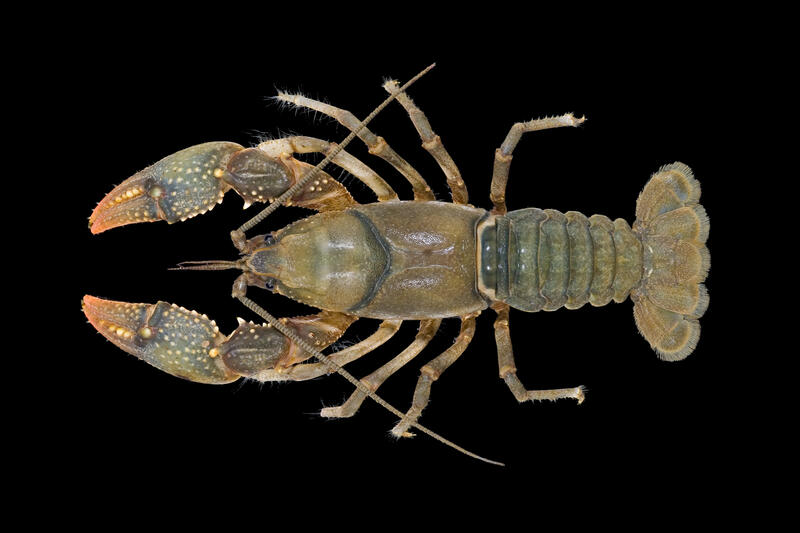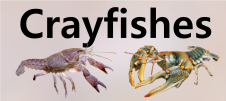







Loading profile. Please wait . . .
Cambarus nodosus Bouchard and Hobbs, 1976
Knotty Burrowing crayfish




Federal Protection: No US federal protection
State Protection: No Georgia state protection
Global Rank: G4
State Rank: S2
Element Locations Tracked in Biotics: No
SWAP 2015 Species of Greatest Conservation Need (SGCN): No
SWAP 2025 Species of Greatest Conservation Need (SGCN): No
2025 SGCN Priority Tier: None
Element Occurrences (EOs) in Georgia: 0
Habitat Summary for element in Georgia: Complex burrows in very wet ditches and seepage areas
The overall color of the Knotty Burrowing Crayfish is light brown or olive to darker greenish-brown. The abdomen appears darker than the carapace. The claws are greenish-brown and are covered with orangish to reddish tubercles. The fingers of the claws are orangish and are brightest towards the tips. There are two rows of tubercles along the mesial margin of the palm; the row right along the edge is well-developed. The areola is fairly wide and the rostrum is short, appears blunt, and does not have marginal spines or tubercles. The largest specimen reported for Georgia has a total body length of about 64 mm (2.5 in).
Since no other primary burrowers occur with the Knotty Burrowing Crayfish it is unlikely to be confused with any other species (Cambarus bartonii is occasionally found in stream bank burrows, see differences below). Very rarely, however, C. nodosus may be found in a stream. In that setting, the species is most likely to be confused with Cambarus bartonii, C. hiwasseensis, or C. parrishi. All three of these species are brownish with darker mottling which differs from the solid coloration of Knotty Burrowing Crayfish. The Knotty Burrowing Crayfish has two rows of tubercles along the mesial margin of the palm which separates it from C. bartonii which only has one row. Lastly, C. nodosus has a blunt, almost square shaped rostrum versus the longer tapered rostrums of C. hiwasseensis and C. parrishi.
The Knotty Burrowing Crayfish is almost always found in burrow systems in seepage areas around streams. Hobbs (1981) also reported them from wet ditches. Burrows are typically complex with many tunnels, particularly where the water table is shallow.
No studies of C. nodosus are known and the diet of burrowing crayfishes in general is poorly understood. Crayfishes are considered opportunistic omnivores and likely feed on a variety of items, both plant and animal, living or dead. Burrowing crayfishes may forage around the mouths of their burrows, eat organisms that crawl or fall into the burrow, or eat worms that inadvertently tunnel through a burrow wall.
Burrowing crayfishes inhabit a system of tunnels that may be very complex with several openings to the surface. Openings to the tunnels are often marked by piles of dirt or mud pellets (chimneys). Depending on the soil type and moisture content, these chimneys can reach heights of 15 cm (6 inches) or more. These crayfishes are typically confined to their burrows, but a male must leave its burrow to search for females during the reproductive season. As mentioned above, they may also forage near the opening of their burrow. Active burrows with fresh soil are seen from late spring to late fall, particularly after rain events. During the dry part of the summer, burrow openings may be plugged to help conserve moisture in the burrow. Reproduction probably occurs during the spring and fall, but males in reproductive condition may be found at any time during the year. It is rare to find more than one adult crayfish in the same burrow. When a female crayfish releases her eggs, she attaches them to her swimmerets and is said to be “in berry.” Upon hatching, the juvenile crayfish are attached to the mother by a thread. After the juveniles molt for the second time, they are free of the mother, but stay close and will hold on to her for some time. Multiple juveniles are occasionally found in a single burrow. Eventually they move off on their own. Crayfishes molt 6 or 7 times during their first year of life and most are probably able to reproduce by the end of that year. They molt once or twice a year for the remainder of their lives. Although it is difficult to study burrowing crayfishes, some researchers believe they may live as long as 10 years. Males in reproductive condition have been collected in Georgia in April, June, and November. Seven females carrying eggs and/or young were found in June. Numbers of eggs ranged from 1-28. Numbers of young on one female was 22 and number of eggs/young on another female was 14/11. The total length of the smallest breeding male from Georgia is about 53 mm (2.1 in) and the smallest female with eggs is about 53 mm (2.1 in) in length (Hobbs 1981).
The Knotty Burrowing Crayfish is typically found in burrows in seepage headwater areas of streams. This species is difficult to collect because the water table is usually near the surface of the ground which typically results in the crayfish excavating an extremely complex burrow system. Several tunnels may have to be followed to find the animal. Despite many tries, I have only collected this species on about 5 occasions.
The Knotty Burrowing Crayfish is found in the headwaters of the Chattahoochee, Savannah, Hiwassee, and Nottely river systems in Georgia, North Carolina, South Carolina, and Tennessee (Eversole and Jones 2004, Hobbs 1981, Simmons and Fraley 2010).
Activities that destroy burrows or alter hydrology in the vicinity of burrows threaten this and other burrowing species.
Despite the somewhat narrow range of this species, it is thought to be stable in Georgia at this time. At least some of its Georgia range is on US Forest Service property which is somewhat protected.
Conserving populations of the Knotty Burrowing Crayfish will require general watershed level protection measures, including the protection of riparian zones, control of sediment and nutrient runoff from farms and construction sites, and limiting the amount of impervious cover (e.g., pavement) within occupied watersheds. Areas with burrows should be protected from land disturbing activities and activities that could alter groundwater resources. Environmental education programs should include information about burrowing crayfishes and encourage protection of burrows.
Eversole, A.G. and D.R. Jones. 2004. Key to the Crayfish of South Carolina. US Forest Service Publication. 79 pp.
Hobbs, H.H., Jr. 1989. An illustrated checklist of the American crayfishes (Decapoda: Astacidae, Cambaridae, and Parastacidae). Smithsonian Contributions to Zoology 480:1–236.
Simmons, J.W. and S.J. Fraley. 2010. Distribution, status, and life-history observations of crayfishes in western North Carolina. Southeastern Naturalist 9 (Special Issue 3):79–126.
Taylor, C.A., G.A. Schuster, J.E. Cooper, R.J. DiStefano, A.G. Eversole, P. Hamr, H.H. Hobbs III, H.W. Robison, C.E. Skelton, and R.F. Thoma. 2007. A reassessment of the conservation status of crayfishes of the United States and Canada after 10+ years of increased awareness. Fisheries 32:372–389.
Christopher E. Skelton
C. Skelton, 2012: original account
C. Skelton, February 2019: general update of account.